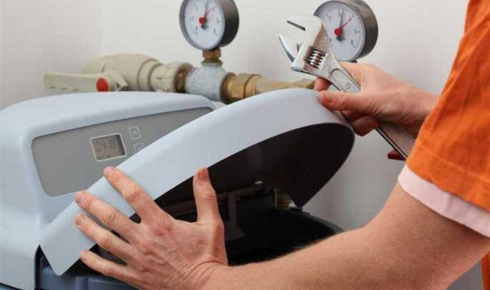If you’ve ever fought those white, chalky spots on your faucets or wondered why your soap just doesn’t lather the way it should, you’re not alone. Across Canada, millions of households experience the subtle — and sometimes not-so-subtle — effects of hard water. It’s one of those everyday issues that quietly shapes how your home feels, how your appliances run, and even how your skin behaves after a shower.
But what exactly makes water “hard”? And more importantly, does it matter? Let’s dive in.
What Makes Water “Hard,” Anyway?
Hard water isn’t dangerous, but it is inconvenient. It’s simply water that contains higher levels of dissolved minerals — mainly calcium and magnesium. These minerals naturally enter the water as it passes through limestone and chalk underground.
The problem starts when those minerals stick around after the water reaches your home. They build up in pipes, faucets, showerheads, kettles, and even your skin. It’s like your home is getting a slow, invisible mineral makeover — but not in a good way.
If you’ve ever asked yourself, does canada have hard water, the short answer is yes — most of it does. In fact, Canada is one of the “hardest water” countries in the developed world, largely because of its geology. Regions that rely on groundwater or well systems tend to have more mineral-heavy water than those using surface water from lakes or rivers.
Everyday Signs You Might Be Living With Hard Water
Hard water reveals itself in small, persistent ways. You might notice:
- Cloudy glassware that never quite looks clean
- Faded clothes, even after gentle washes
- Dry, tight skin after showering
- White mineral spots on stainless steel sinks
- Coffee makers and kettles with crusty buildup
Your plumbing may even complain — literally. Limescale accumulation inside pipes restricts flow, lowers water pressure, and forces water heaters to work overtime. That means higher energy bills and shorter appliance lifespans.
If these signs sound familiar, it’s worth confirming your water hardness before making changes. That brings us to the next point: how to check water hardness without needing a full laboratory setup.
How to Test Your Water Like a Pro
Testing water hardness is surprisingly simple. You can do it at home in just a few minutes.
- The Soap Bottle Trick — Fill a clear bottle halfway with tap water, add a few drops of pure liquid soap (not detergent), and shake. If it foams up quickly, your water is soft. If it stays cloudy and flat, it’s hard.
- Hardness Test Strips — Available online or at most hardware stores, these paper strips change color based on the mineral content in your water. They’ll tell you roughly how “hard” your water is in parts per million (ppm) or grains per gallon (gpg).
- Municipal Reports — If you live in an urban area, your city or regional website often lists local water quality data, including hardness levels.
Most experts classify water like this:
- 0–60 ppm: Soft
- 61–120 ppm: Moderately hard
- 121–180 ppm: Hard
- 180+ ppm: Very hard
Anything over 120 ppm means you’ll probably start noticing effects around your home.
How Hard Is Winnipeg’s Water, Exactly?
If you’re from Manitoba, you might be curious — is winnipeg water hard or soft? It’s actually considered moderately hard. Winnipeg sources most of its water from Shoal Lake, located east of the city. While lake water typically has fewer minerals than groundwater, it still carries some hardness due to the surrounding geology.
On average, Winnipeg’s water hardness sits around 80–90 ppm. That’s enough to leave a few mineral traces here and there, but not quite at the level that requires aggressive softening systems. Still, locals often notice dry skin or small calcium deposits on faucets over time.
Interestingly, water hardness levels in Canada can vary dramatically even within the same province. For example, neighboring areas like Brandon or Steinbach, which rely more on wells and groundwater, experience much harder water — often above 300 ppm.
Why Hard Water Isn’t Harmless for Your Home
Even though it’s not unsafe to drink, hard water does have a hidden cost. Over time, the minerals that make it “hard” accumulate in your plumbing and appliances. That buildup — known as limescale — reduces efficiency and increases wear.
A water heater coated in just a thin layer of limescale can lose up to 25% of its heating efficiency. That’s not just bad for the environment; it’s bad for your wallet. Meanwhile, dishwashers and washing machines work harder too, leaving you with streaky dishes and rough fabrics.
Then there’s the personal side — skin and hair. Hard water can strip away natural oils, leading to dryness, frizz, and irritation. You might even notice your shampoo doesn’t lather as well or your laundry detergent needs more scoops to get results.
What You Can Do About It
If testing confirms you have hard water, you’ve got options. Some are quick fixes; others are long-term investments.
- Install a Water Softener: The gold-standard solution. A softener uses ion exchange to replace calcium and magnesium ions with sodium or potassium. It’s the most reliable way to eliminate scale and improve water feel.
- Use Descalers: For smaller issues, magnetic or electronic descalers can reduce buildup without altering water composition.
- Vinegar Cleansers: Regularly soak showerheads and faucets in vinegar to dissolve limescale naturally.
- Switch Products: Use detergents and shampoos formulated for hard water. They contain special agents that prevent mineral interaction.
If you’re in a rental or can’t install a softener, even small changes — like using distilled water in your kettle or humidifier — can make a big difference.
Canada’s Water Story — Hard but Manageable
Here’s the reality: hard water isn’t a flaw, it’s just nature doing its thing. Canada’s unique geology — full of limestone-rich regions and deep aquifers — makes it almost impossible to avoid. But it’s not all bad news. Once you understand what’s coming out of your tap, you can work with it instead of against it.
Cities are increasingly transparent about their water data, and modern filtration technologies make dealing with hardness easier than ever. Whether you’re in Winnipeg, Toronto, or Saskatoon, being informed helps you take better care of your home — and yourself.
A Thought to Close With
We often think of water as simple — clear, pure, and constant. But like most things in life, it’s more complex than it appears. Those invisible minerals swirling through your tap tell a geological story millions of years in the making.

